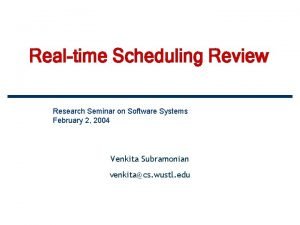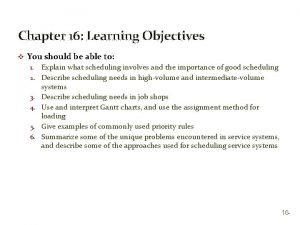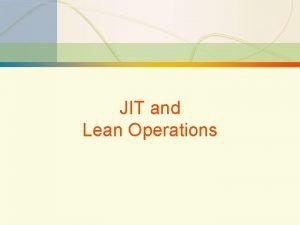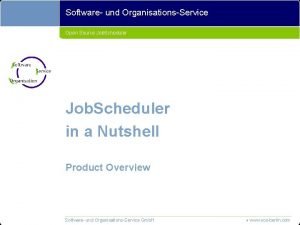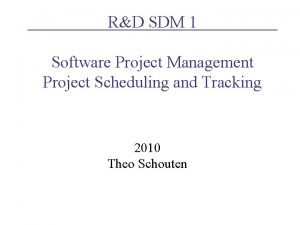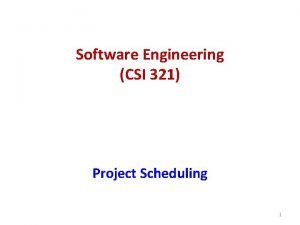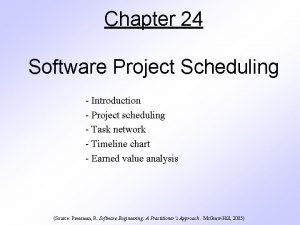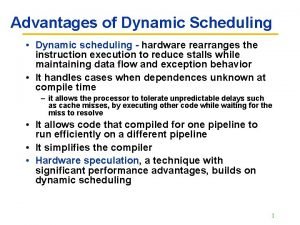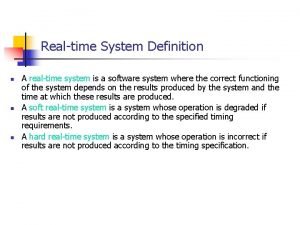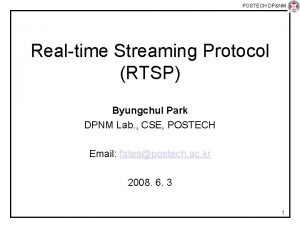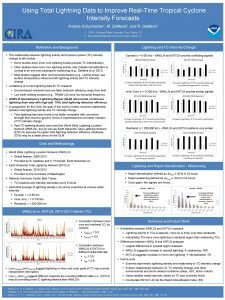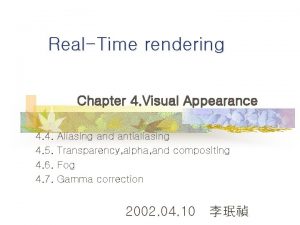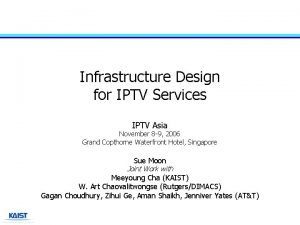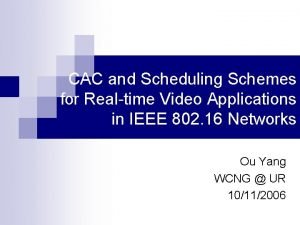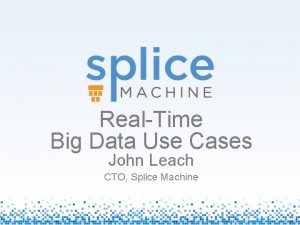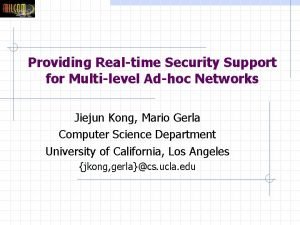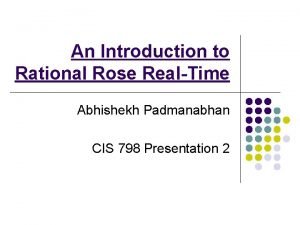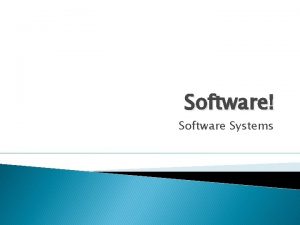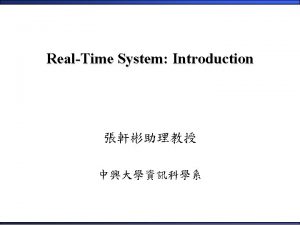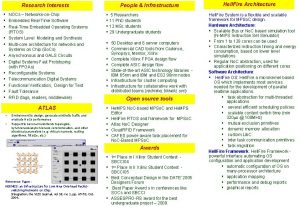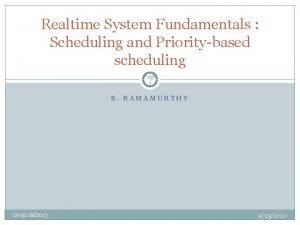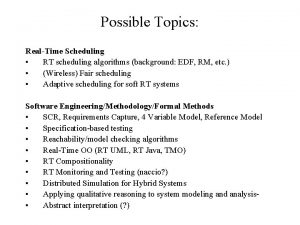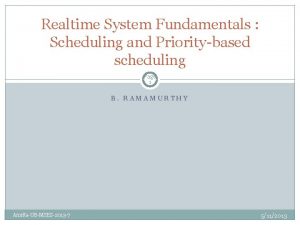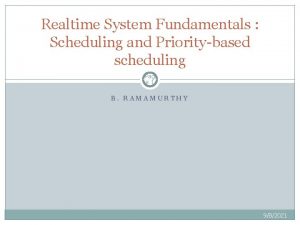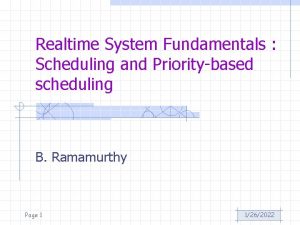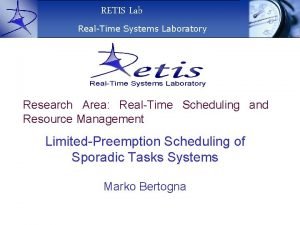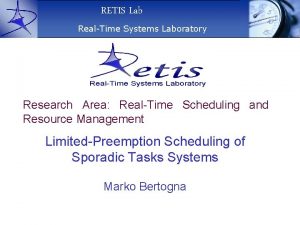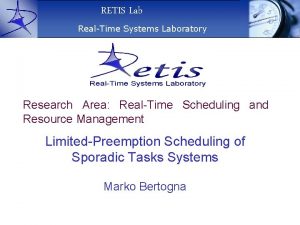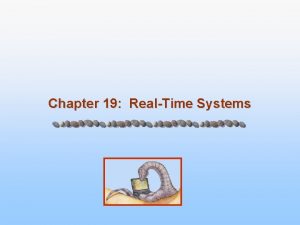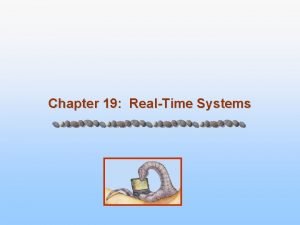Realtime Scheduling Review Research Seminar on Software Systems



































- Slides: 35

Real-time Scheduling Review Research Seminar on Software Systems February 2, 2004 Venkita Subramonian venkita@cs. wustl. edu

Main Topics for Discussion § Single Processor Scheduling § End-to-end Scheduling § Holistic Scheduling

What is a Real-time System? § Real-time systems have been defined as: “those systems in which the correctness of the system depends not only on the logical result of the computation, but also on the time at which the results are produced"; § J. Stankovic, "Misconceptions About Real-Time Computing, " IEEE Computer, 21(10), October 1988. § Real-time does not necessarily mean “Real fast”. § Predictability is key in real-time systems § “There was a man who drowned crossing a stream with an average depth of six inches” – J. Stankovic

Real-time Scheduling § Job (Jij): Unit of work, scheduled and executed by system. Jobs repeated at regular or semi-regular intervals modeled as periodic § Task (Ti): Set of related jobs. § Jobs scheduled and allocated resources based on a set of scheduling algorithms and access control protocols. § Scheduler: Module implementing scheduling algorithms § Schedule: assignment of all jobs to available processors, produced by scheduler. § Valid schedule: All jobs meet their deadline § Clock-driven scheduling vs Event(priority)-driven scheduling § Fixed Priority vs Dynamic Priority assignment

Scheduling Periodic Tasks § In hard real-time systems, set of tasks are known apriori § Task Ti is a series of periodic Jobs Jij. Each task has the following parameters § § § pi - period, minimum interrelease interval between jobs in Task Ti. ei - maximum execution time for jobs in task Ti. rij - release time of the jth Job in Task i (Jij in Ti). i - phase of Task Ti, equal to ri 1. ui - utilization of Task Ti = ei / pi § In addition the following parameters apply to a set of tasks § H - Hyperperiod = Least Common Multiple of pi for all i: H = lcm(pi), for all i. § U - Total utilization = Sum over all ui. § Schedulable utilization of an algorithm Us § If U < Us the set of tasks can be guaranteed to be scheduled

Fixed Priority Algorithms § Rate Monotonic scheduling § § § Priority assignment based on rates of tasks Higher rate task assigned higher priority Schedulable utilization = 0. 693 (Liu and Leyland) If U < 0. 693, schedulability is guaranteed Tasks may be schedulable even if U > 0. 693 § Deadline Monotonic scheduling § Priority assignment based on relative deadlines of tasks § Shorter the relative deadline, higher the priority § Useful when relative deadline ≠ period § Both of the above usually done off-line since fixed priority assigned at task level § Online dispatcher enforces the schedule by dispatching higher priority jobs before lower priority jobs

Dynamic Priority Algorithms § Online scheduler assigns priorities for jobs released § Dispatcher dispatches the highest priority job § Suitable for scheduling aperiodic as well as periodic tasks § Earliest Deadline First (EDF) § Priority assignment based on absolute deadline of jobs § Job with closest deadline assigned highest priority § Schedulable utilization = 1 § Least Laxity First (LLF) § § Laxity = Absolute Deadline – Worst case computation time Priority assignment based on laxity of jobs Job with minimum laxity assigned highest priority Schedulable utilization = 1 § Dynamic Priority algorithms provide better processor utilization than Fixed Priority algorithms

Hybrid algorithms § Not all algorithms are robust in overload situations § To improve predictability for critical tasks, use a combination of fixed and dynamic priority algorithms § Tasks divided based on criticality – critical and non-critical § Critical tasks scheduled using fixed priority assignment § Non-critical tasks scheduled based on dynamic priority assignment § Examples - Maximum Urgency First, RM + MLF

Blocking factors § Sometimes a higher priority job cannot run because § Currently running lower priority job is non-preemptive (priorityinversion) § E. g. , non-preemptable system call § Self-suspension § E. g. , i/o operations, remote calls § Above blocking delays need to be taken into account while doing schedulability analysis § Blocking delay should include § Maximum blocking time due to non-preemptability of lower priority tasks § Maximum own self suspension time and maximum self-suspension time of all higher priority tasks § Context switches

ORB endsystem example (1/2) Wait-on-Connection § § § Wait-on-Reactor Reply. Handler in ORB waits on socket § Reply. Handler waits in reactor for the reply connection for the reply § Reactor gets a chance to process other § Blocking call to recv() requests while replies are pending § One less thread listening on the § Interleaving of request reply Reactor for new requests processing, hence interference from other requests while reply is pending No interference from other requests that arrive when reply is pending § Ideal for single threaded processing However, could cause deadlocks on nested upcalls.

ORB endsystem example (2/2) § Wait-on-Reactor strategy could cause interleaved request/reply processing f 2 f 5 § Blocking factor could be bounded or unbounded f 3 f 6 § Based on the upcall duration § And number of intervening upcalls f 5 reply queued § Blocking factors may affect real-time properties of other end-systems § Call-chains can have a cascading blocking effect Blocking factor f 2 f 3 returns f 2 returns f 5 reply processed

Algorithm selection Single Processor Periodic RMS/MUF/DM Periodic, Blocking RMS/MUF/DM with Priority Ceiling Periodic? , Predictable Overload behavior MUF, RM+MLF Maximum Utilization EDF, MLF

End to End Scheduling

End-to-end task model § A task is composed of multiple subtasks running on multiple processors § Remote method invocation § Non-local event § Messages § Subtasks are subject to precedence constraints § Task = a chain of subtasks § A task is subject to an end-to-end deadline § Does not care about the response time of a particular subtask § End-to-End scheduling should address § § Task allocation : bind tasks to processors Synchronization protocols : to enforce precedence constraints Subdeadline assignment Schedulability analysis Thanks to Dr. Lu for permitting to use material from CS 520 slides

Task Allocation § Strategies § Offline, static allocation § Allocate a task when it arrives § Re-allocate (migrate) a task after it starts § NP-hard: heuristics needed § Bin-Packing formulation § Pack subtasks to bins (processors) with limited capacity § “Size” of a subtask Ti, j: ui, j = ei, j/pi § “Capacity” of each bin is its utilization bound, e. g. , 0. 69 (RMS) or 1 (EDF) under ideal assumptions § Goal: minimize the number of bins subject to the capacity constraints Thanks to Dr. Lu for permitting to use material from CS 520 slides

The Synchronization Problem § Given that § Priorities are assigned to subtasks in a task chain using some fixed priority assignment algorithm § How do we coordinate the release of subtasks in a task chain so that § Precedence constraints among subtasks are satisfied § subtask deadlines are met § end-to-end deadlines are met

Synchronization Protocols § Direct Synchronization (DS) Protocol § Simple and straightforward § Phase Modification (PM) Protocol § Proposed by Bettati § Extension called Modified Phase Modification (MPM) Protocol § Release Guard Protocol § Proposed by Sun

Synchronization Protocol - Example T 1 (4, 2) P 1 T 2, 1 (6, 2) Ti, j – jth subtask of task Ti (period, execution time) Period = relative deadline of parent task T 2, 2 (6, 2) P 2 T 3 (6, 3) Task T 3 has a phase of 4 time units

Direct Synchronization Protocol § Greedy strategy § On completion of subtask § A synchronization signal sent to the next processor § Successor subtask competes with other tasks/subtasks on the next processor

Direct Synchronization Illustrated T 1 (4, 2) T 2, 2 (6, 2) P 1 P 2 T 2, 1 (6, 2) T 3 (6, 3) T 1 2 4 6 8 10 12 T 2, 1 On P 2 T 2, 2 Phase of T 3 2 T 3 misses deadline

Phase Modification Protocol § Proposed by Bettati § Release subtasks periodically § According to the periods of their parent tasks § Each subtask given its own phase § Phase determined by subtask precedence constraints

Phase Modification Protocol Illustrated (1/2) T 1, 1 T 1, 2 p 1 T 1, 3 p 1 Phase of T 1, 2 Actual response time Phase of T 1, 3 Estimated worst case response time T 1, 3

Phase Modification Protocol Illustrated (2/2) T 1 2 4 6 8 10 12 T 2, 1 On P 2 Phase of T 2, 2 2 Phase of T 3 2 (4, 2) T 2, 2 (6, 2) P 1 P 2 T 2, 1 (6, 2) T 3 (6, 3)

Phase Modification Protocol - Analysis § Periodic Timer interrupt to release subtasks § Centralized clock or strict clock synchronization § Task overruns could cause Precedence constraint violations

Modified PM Protocol Illustrated (1/2) T 1, 1 T 1, 2 p 1 T 1, 3 Overrun ∆ p 1 + ∆ Actual response time Estimated worst case response time

Modified PM Protocol Illustrated (2/2) T 1 (4, 2) 4 6 8 10 P 2 T 2, 1 (6, 2) T 3 (6, 3) 12 Synch signal delayed T 2, 1 On P 1 2 4 6 8 10 12 On P 2 T 2, 2 Phase of T 3 2 (6, 2) P 1 T 1 2 T 2, 2

Modified PM Protocol - Analysis § MPM protocol behavior the same as PM under ideal conditions § Ideal conditions – Clocks synchronized, no overrun § MPM protocol does not need clock synchronization § Precedence constraints preserved even in the case of overruns § Upper bound on End-to-End Response time of task Ti Ri, k is the response time of the kth subtask of Ti ni is the number of subtasks for the task Ti § Lower bound on End-to-End Response time of task Ti + Actual Response time of nith subtask § Lower bound high, hence high average EER time, but low output jitter

Release Guard Protocol § Proposed by Sun § A guard variable – release guard - associated with each subtask § Release guard used to control release of each subtask § Contains next release time of subtask § Synchronization signals just like MPM § Release guard updated § On getting synchronization signal § During idle time

Release Guard Protocol Illustrated T 1 (4, 2) T 2, 2 (6, 2) P 1 P 2 T 2, 1 (6, 2) T 3 (6, 3) T 1 2 4 6 8 10 12 T 2, 1 On P 2 g 1, 2 = 4+6=10 g 1, 2 = 9 T 2, 2 2 4 6 8 10 12 Idle time detected Phase of T 3 2 4 6 8 10 12

Release Guard Protocol - Analysis § Shares the same advantages as MPM § Upper bound on EER still the same as MPM § Since upper bound on release time enforced by release guard Ri, k is the response time of the kth subtask of Ti ni is the number of subtasks for the task Ti § Lower bound on EER less than that of MPM § If there are idle times § Results in lower average EER

Subdeadline Assignment § Subdeadline -> priorities under EDF & DM § Optimal subdeadline assignment is NP-hard § Offline: heuristic search algorithms § Online: simpler heuristics § Effective Deadline (ED): § Work backwards from the end-to-end deadline § Slack assignment § Assign all slack to 1 st subtask § Assign slack proportionally to execution time § Assign more slack to subtasks on busier processors Thanks to Dr. Lu for permitting to use material from CS 520 slides

Holistic Scheduling § Combine processor scheduling with communication bus scheduling to provide an integrated schedulability analysis § Calculate bounds on end-to-end delays in distributed systems including communication delays § Typically used in hard real-time systems to calculate the worst case end-to -end response time of tasks

Algorithm selection § Use MPMP or RG if § Information about all tasks are available a priori § System has global clock sync § Otherwise only RG can be used § Use MPMP for low jitter and RG for lower average EER

References § Synchronization Protocols in Distributed Real-Time Systems, ICDCS 96 § Jun Sun, Jane Liu § Real-time Systems § Jane Liu § Holistic Schedulability for Distributed Hard Real-time Systems, Microprocessing and Microprogramming - Euromicro Journal 1994 (Special Issue on Parallel Embedded Real-Time Systems) § Ken Tindell, John Clark § VEST: An Aspect-Based Composition Tool for Real-Time Systems, RTAS 2003 § Stankovic, Lu, et. al

DM with phase offset
 Seminar scheduling software
Seminar scheduling software Realtime aps software
Realtime aps software Job scheduling vs process scheduling
Job scheduling vs process scheduling Eic software software review
Eic software software review Scheduling in high-volume systems is known by what term?
Scheduling in high-volume systems is known by what term? Jit inventory
Jit inventory Open source distributed job scheduler
Open source distributed job scheduler Sdm in project management
Sdm in project management Csi 321
Csi 321 Foxwoods dealer scheduling
Foxwoods dealer scheduling Compartmentalization interdependency effort validation r
Compartmentalization interdependency effort validation r Advantages of dynamic programming
Advantages of dynamic programming Maximo scheduler run optimization
Maximo scheduler run optimization Compartmentalization interdependency effort validation r
Compartmentalization interdependency effort validation r Illinois boys lacrosse association
Illinois boys lacrosse association Realtime system
Realtime system Realtime database push
Realtime database push Realtime streaming protocol
Realtime streaming protocol Curis realtime
Curis realtime What is real-time interaction management
What is real-time interaction management Lightning realtime
Lightning realtime Simple online and realtime tracking
Simple online and realtime tracking Rendering realtime compositing
Rendering realtime compositing Real time characteristics of embedded operating systems
Real time characteristics of embedded operating systems Realtime communications
Realtime communications Realtime it
Realtime it Realtime it
Realtime it Realtime it
Realtime it Iptv infrastructure
Iptv infrastructure Cac realtime
Cac realtime Realtime forex
Realtime forex Eva rov
Eva rov Rendering realtime compositing
Rendering realtime compositing Realtime big data
Realtime big data Ad hoc realtime
Ad hoc realtime Rational rose realtime
Rational rose realtime
